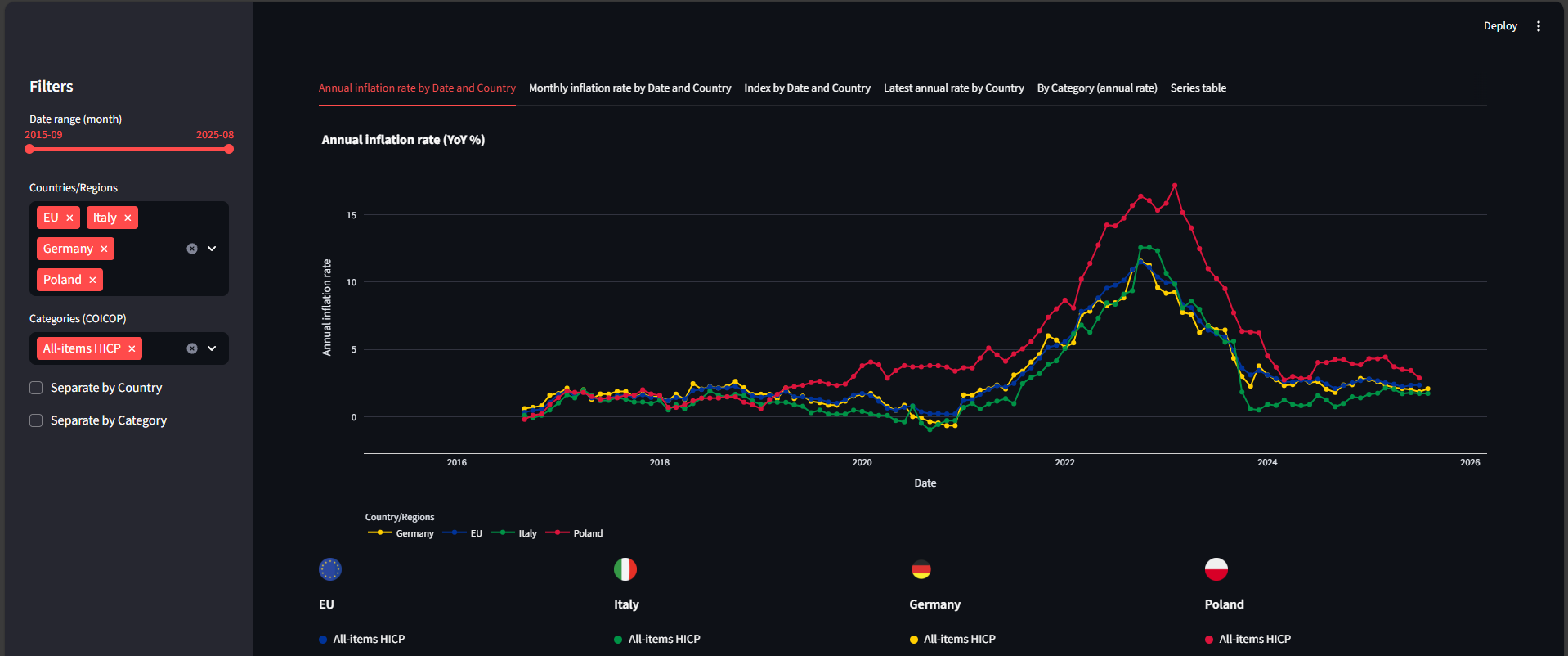Eurostat HICP (EU-27) — Power BI
EU-themed Power BI model for the Harmonised Index of Consumer Prices (HICP). Includes a clean star schema, core DAX measures (Index, Monthly/Annual rates), and refreshable Eurostat API ingestion in Power Query (M). A lightweight Python app version is available too.




Click any image to enlarge.
Data Model
Tables
- FactHICP_Index
- FactHICP_Rates_YoY
- FactHICP_Rates_MoM
- FactHICP_Weights
- DimDate
- DimGeo
- DimCOICOP
Facts are filtered by DimDate, DimGeo, and DimCOICOP (single-direction). Separate facts keep rates lean and queryable without row-level recomputation.

Core DAX Measures
Below are the core measures used throughout the report. More measures are available in the repository.
Index =
AVERAGE ( FactHICP_Index[value] )
Annual inflation rate =
VAR Prev12 =
CALCULATE (
[Index],
DATEADD ( DimDate[Date], -12, MONTH ),
KEEPFILTERS ( VALUES ( DimGeo[geo] ) ),
KEEPFILTERS ( VALUES ( DimCOICOP[coicop] ) )
)
RETURN
IF ( ISBLANK ( Prev12 ), BLANK (), DIVIDE ( [Index] - Prev12, Prev12 ) )
Monthly inflation rate =
VAR Curr = [Index]
VAR Prev = CALCULATE ( [Index], DATEADD ( DimDate[Date], -1, MONTH ) )
RETURN DIVIDE ( Curr - Prev, Prev )Power Query (M) — Eurostat API
let
// --- Parameters ---
dataset = "prc_hicp_midx",
unitCode = "I15",
startMonth = pStartMonth,
endMonth = pEndMonth,
geosList = pGeos,
coicopsList = pCoicops,
// --- Eurostat Statistics API URL ---
Base = "https://ec.europa.eu/eurostat/api/dissemination/statistics/1.0/data/",
Parts = List.Combine({
{"lang=EN","freq=M","unit=" & unitCode,
"sinceTimePeriod=" & startMonth,"untilTimePeriod=" & endMonth},
List.Transform(coicopsList, each "coicop=" & _),
List.Transform(geosList, each "geo=" & _)
}),
Url = Base & dataset & "?" & Text.Combine(Parts, "&"),
// --- Fetch + parse JSON-stat 2.0 ---
Raw = Web.Contents(Url, [Timeout=#duration(0,0,90,0), Headers=[Accept="application/json"]]),
J = Json.Document(Raw),
D = if Record.HasFields(J, "dataset") then J[dataset] else J,
// --- Dimensions (lower-cased) ---
Ids = List.Transform(D[id], each Text.Lower(Text.From(_))),
DimR = Record.FromList(Record.FieldValues(D[dimension]),
List.Transform(Record.FieldNames(D[dimension]), Text.Lower)),
GetCodes = (dimname as text) as list =>
let d = Record.Field(DimR, dimname),
cat = d[category],
idx = try cat[index] otherwise null,
codes =
if idx <> null then
if Value.Is(cat[index], type list) then List.Transform(cat[index], each Text.From(_))
else if Value.Is(cat[index], type record)
then List.Transform(Table.Sort(Record.ToTable(cat[index]), {{"Value", Order.Ascending}})[Name], each Text.From(_))
else Record.FieldNames(cat[label])
else if Record.HasFields(cat,"label") then Record.FieldNames(cat[label]) else {}
in codes,
Codes = List.Transform(Ids, each GetCodes(_)),
Sizes = List.Transform(Codes, each List.Count(_)),
Mdim = List.Count(Sizes),
N = if Mdim=0 then 0 else List.Product(Sizes),
// --- Dense values vector (FIXED ReplaceRange call) ---
ValRaw = D[value],
Values =
if Value.Is(ValRaw, type list) then ValRaw
else if Value.Is(ValRaw, type record) then
let names = Record.FieldNames(ValRaw),
vals = Record.FieldValues(ValRaw),
pos = List.Transform(names, each Number.FromText(_)),
base = List.Repeat({null}, N),
zipped= List.Zip({pos, vals}),
filled= List.Accumulate(zipped, base, (st, p) => List.ReplaceRange(st, p{0}, 1, {p{1}}))
in filled
else List.Repeat({null}, N),
// --- Build columns (last dimension varies fastest) ---
Result =
if N=0 then #table(Ids & {"value"}, {})
else
let
idxs = {0..N-1},
radices = List.Transform({0..Mdim-1}, each if _=Mdim-1 then 1 else List.Product(List.Range(Sizes, _+1, Mdim-(_+1)))),
DimCol = (k as number) =>
let sizeK = Sizes{k}, radK = radices{k}, codeK = Codes{k}
in List.Transform(idxs, (i)=> codeK{ Number.Mod(Number.IntegerDivide(i, radK), sizeK)}),
Tbl = Table.FromColumns(List.Transform({0..Mdim-1}, each DimCol(_)) & {Values}, Ids & {"value"})
in Tbl,
// --- Clean & keep core fields ---
Lower = Table.TransformColumnNames(Result, Text.Lower),
Norm = if List.Contains(Table.ColumnNames(Lower), "time_period")
then Table.RenameColumns(Lower, {{"time_period","time"}}) else Lower,
WithUnit= if List.Contains(Table.ColumnNames(Norm), "unit")
then Norm else Table.AddColumn(Norm, "unit", each unitCode, type text),
Keep = Table.SelectColumns(WithUnit, {"time","geo","coicop","unit","value"}, MissingField.Ignore),
Typed = Table.TransformColumnTypes(
Keep,
{{"time", type text},{"geo", type text},{"coicop", type text},{"unit", type text},{"value", type number}},
"en-US"
),
AddDate = Table.AddColumn(Typed, "Date", each Date.FromText([time] & "-01"), type date)
in
AddDate
Parameters pStartMonth, pEndMonth, pGeos, pCoicops scope refresh.
Python App (Interactive Explorer)
A lightweight, tabbed web app that lets you slice the Eurostat HICP data by time window, geographies, and COICOP categories, and then view index levels plus monthly/annual rates in charts and tables. Filters live in a compact panel; tabs switch between overview, trends, and comparisons. Data is pulled/reshaped in helpers and shared across tabs via a simple app state.

Data & Viz Highlights
Open app/ on GitHubfilters.py — user controls
Open file# Countries/regions and COICOP categories (trimmed example)
GEOS = ["EU", "DE", "IT", "PL"]
COICOPS = ["CP00", "CP011", "CP012"] # All-items + examples
# Default time window (Eurostat YYYY-MM)
DEFAULT_START = "2016-01"
DEFAULT_END = "2025-01"helpers.py — Eurostat fetch & shaping
Open fileimport requests, pandas as pd
BASE = "https://ec.europa.eu/eurostat/api/dissemination/statistics/1.0/data/prc_hicp_midx"
def build_url(start, end, geos, coicops, unit="I15"):
params = [f"lang=EN", f"freq=M", f"unit={unit}",
f"sinceTimePeriod={start}", f"untilTimePeriod={end}"]
params += [*(f"geo={g}" for g in geos), *(f"coicop={c}" for c in coicops)]
return f"{BASE}?" + "&".join(params)
def add_rates(df):
df = df.sort_values("Date")
g = df.groupby(["geo", "coicop"], sort=False)
df["Prev"] = g["value"].shift(1)
df["Prev12"] = g["value"].shift(12)
df["MoM"] = (df["value"] - df["Prev"]) / df["Prev"]
df["YoY"] = (df["value"] - df["Prev12"]) / df["Prev12"]
return dfThe rate formulas mirror DAX measures (MoM/YoY) so the Python app matches Power BI outputs.
tabs.py — Plotly visuals (example)
Open fileimport plotly.express as px
def annual_rate_by_country(df, coicop="CP00"):
d = df[df["coicop"] == coicop]
fig = px.line(
d, x="Date", y="YoY", color="geo",
title="Annual inflation rate (YoY %) — by date and country",
labels={"YoY": "YoY (%)"}, markers=False
)
fig.update_yaxes(tickformat=".1%")
fig.update_layout(template="plotly_dark", legend_title_text="")
return figmain.py — wiring
Open file# Pseudocode wiring (framework-agnostic)
from helpers import build_url, tidy_from_jsonstat, add_rates
from tabs import annual_rate_by_country
from filters import GEOS, COICOPS, DEFAULT_START, DEFAULT_END
import requests
url = build_url(DEFAULT_START, DEFAULT_END, GEOS, COICOPS)
js = requests.get(url, headers={"Accept":"application/json"}, timeout=60).json()
df = add_rates(tidy_from_jsonstat(js))
fig = annual_rate_by_country(df)
# render(fig) # Streamlit, Dash, or your chosen UI toolkit